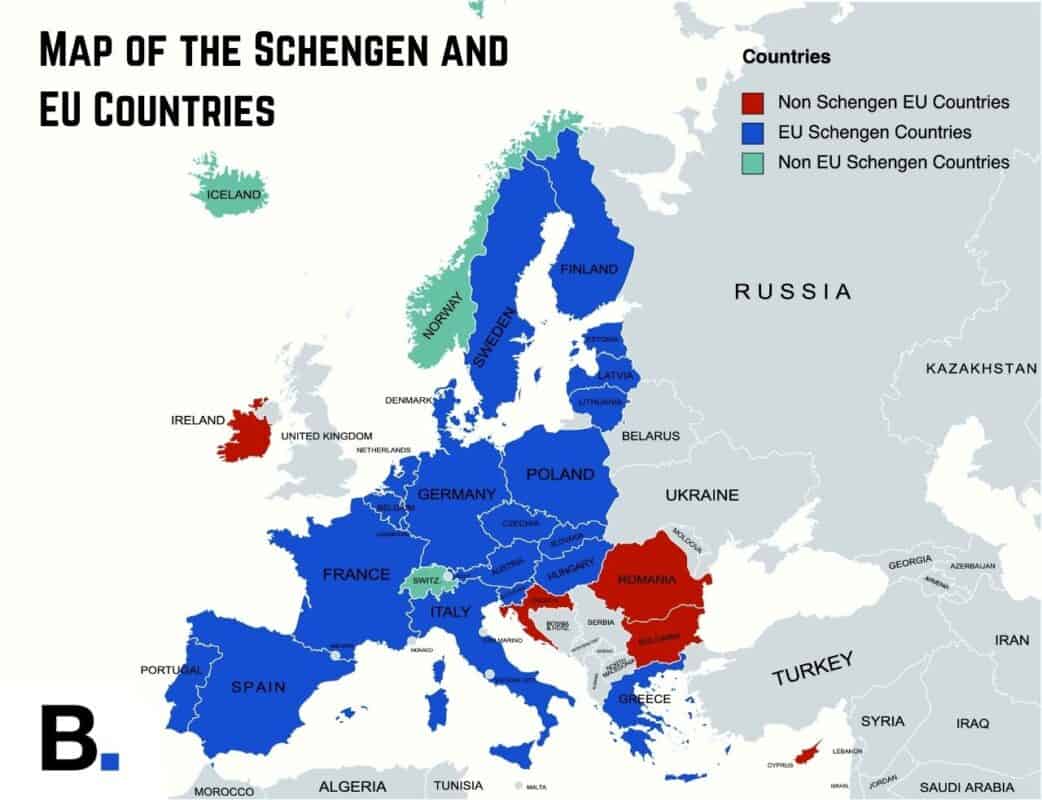How to (Legally) Stay in Europe for More Than 90 Days

Last Updated: 6/25/22 | June 25th, 2022
When I planned my move to Sweden a few years ago, I tried to figure out how to get past the 90-day limit placed on tourist visas in the Schengen Area. This is a problem encountered by thousands of travelers every year and a question that regularly (especially this time of year) pops up in my inbox.
“How can I stay in Europe for more than 90 days?”
It’s a simple question with a very complicated answer.
I always knew it was complicated, but until I started researching how to stay there longer, I never knew just how complicated.
Fortunately, in the process of this research, I came to learn there are a few ways to stay in Europe longer than 90 days; they just aren’t well known.
This post will teach you the options for staying in Europe over 90 days as well as give you tips on how to move to Europe. But first a few things:
It’s important to note that Europe isn’t just one place — there are varying visa rules throughout the continent. When people talk about the “90-day limit,” they’re talking about restrictions on the Schengen Area, which is the visa policy that governs 26 countries in Europe. It includes most of the European Union as well as a few non-EU countries.
Note: While I call it the “Schengen Visa,” it’s not an actual visa you necessarily need to apply for. Depending on your residency status and country of citizenship, you may need to apply in advance for a Schengen Visa, however, those with an American passport do not need to apply in advance.
Table of Contents
What is the Schengen visa?
The Schengen visa is a 90-day tourist visa for Schengen Area countries, which are:
Additionally, there are several microstates that are de facto members of the Schengen Area. These are Monaco, San Marino, and Vatican City.
These Schengen countries have a border-free visa agreement that lets residents move throughout the Area without needing to show their passport every time they cross a border. Essentially, it’s as if they’re one country, and you can move as freely as you want.
Citizens of many countries are allowed to enter the Schengen Area without having to get a visa beforehand. Your passport simply gets stamped upon your arrival and departure from Europe. You’re allowed to enter and leave from any country you want — they don’t have to be the same.
Most visitors (including Americans) are allowed to spend 90 days in the Schengen Area in every 180-day period. The easiest way to think of it is that you can visit for 3 months and then you have to leave for 3 months before you can return.
However, you can also bounce back and forth between Schengen and non-Schengen countries — you just need to keep track of all your dates of entry/exit.
When I visit Europe, I fly in and out of different countries all the time. Your first entry in the 180-day period is when your 90-day counter starts. These days don’t need to be consecutive — the total is cumulative. Once day 181 hits, the count resets itself.
For example, if I come to the Schengen Area in January and stay for 60 days and then come back in June for 10 days, that counts as 70 days in 180 days. Only days you are in the zone during the period count. If you go on January 1st and stay 90 straight days, you have to leave and technically can’t come back until July 1st.
If you’re doing a lot of bouncing around, use the EU’s Schengen visa calculator. Simply input all your travel dates and it’ll tell you how many days you have remaining.
However, not all travelers are allowed such freedom.
Citizens from many countries need to apply for a Schengen visa ahead of time. You’ll be required to fill out paperwork beforehand and fly in and out of the country for which your visa is issued.
Even then, you still might not be granted a visa. Spoiler alert: citizens from African and Asian countries get screwed.
So, with that being said, how DO you stay in Europe longer? How do you get around that rule? Let me break it down for you.
Part 1: Staying or Moving to Europe the Easy Way

With so many visa rules, it’s easy to stay in Europe beyond 90 days as a tourist — you just need to mix up the countries you visit. The United Kingdom has its own rules that allow you to stay 180 days in a calendar year.
Most non-Schengen countries such as Ukraine, Moldova, Croatia, Ireland, and some Balkan countries allow you to stay for up to 60 or 90 days. Albania even lets Americans stay up to a year!
So, all you need to do to stay in Europe longer than 3 months is spend 90 days in the Schengen Area and then visit the UK, go to the Balkans, hang out in Ukraine, drink wine in Moldova, and have a pint in Ireland. If you align your schedule right, you can easily be out of the Schengen Area for 90 days and then head back into the Schengen Area with a brand new Schengen visa.
Years ago, to get around this limit, I spent three months in Bulgaria, Romania, Ukraine, and England as I waited for my clock to reset. After that, I headed back into the Shengen area for Oktoberfest.
If you want to travel the continent for a long time without having to go through the various visa processes described below, vary your travel by visiting non-Schengen countries. There’s plenty of countries to choose from while you wait for your Schengen Visa clock to reset. This is the easy, hassle-free way of doing things.
Part 2: Staying in the Schengen Area Past 90 Days

But what if you do want to stay longer in the Schengen Area? What if the six months you want to be in Europe is all in Schengen Area countries? What if you want to live and work in Europe?
After all, the Schengen Area spans 26 countries and visiting so many destinations in 90 days can be a little rushed (you would have an average of just 3.5 days per country).
If you want to stay longer to travel, live, learn a language, or fall in love, then the “move around” option suggested above isn’t going to work for you. You need something else.
Luckily, there are a few ways to do this — and I can’t stress enough the importance of the word “few.” Because staying more than 90 days in the Schengen Area isn’t easy.
First, let’s understand the rule:
The Schengen law states that you can’t stay in the Schengen Area for more than 90 days. If you do, you’re subject to a fine and possibly deportation and being banned from re-entering the Schengen Area. How that rule is enforced, though, varies greatly from one country to another. Overstaying by a day might not be the end of the world, however, some countries do not mess around with visitors overstaying.
For example, Germany, the Netherlands, Poland, Switzerland, and Scandinavian countries are all very strict about entry and exit rules. If you overstay your tourist visit, there’s a good chance they’ll pull you aside. Two Australians I know were detained leaving Switzerland due to overstaying their visa by two weeks. They were allowed to go with just a warning, but they missed their flights and had to book new flights.
I know of someone who overstayed by six months, tried to leave from Amsterdam, and now has an “illegal immigrant” stamp on her passport. In order to enter Europe again, she must apply for a visa at an embassy and be preapproved:
I made the mistake of attempting to leave from the Netherlands after overstaying a Schengen visa and was caught. I overstayed by about a month, and they hand-drew some sort of insignia in my passport to note my overstay. They told me I’d have to contact the IND and find out if I would be able to enter the Schengen states again.
Another blogger told me this happened to them too so don’t overstay your visa!
That being said, if you leave from Greece, France, Italy, or Spain you may be less likely to encounter an issue, provided you (a) haven’t stayed over too long and (b) didn’t catch the immigration officer on a bad day.
When I left Greece, no one even looked at my passport. One of my friends met a guy in France, fell in love, and decided not to leave. A year later, when she finally did, the French officials didn’t even look twice. Another friend flew into France and didn’t even get an entry stamp. Spain is another place notorious for not caring and Americans who decide to overstay for months mention that as the easiest country to exit from.
Of course, I don’t think it’s wise to overstay. A day or two? Likely not the end of the world. But, Matt, can I extend just extend my Schengen visa/stamp?
Unfortunately not. Simply put, you cannot extend your tourist visa or entry stamp. There’s a 90-day limit, and that’s that.
So what’s a tourist to do?
1. Take advantage of the Bilateral Agreement Hack

In addition to the standard Schengen visa, many countries have numerous bilateral agreements independent of the Schengen visa. These agreements let travelers stay in a specific country for an additional period of time beyond the 90-day Schengen limit. The only caveat is that can’t leave that country during that time.
For example, France has a bilateral agreement that allows U.S. citizens to stay an additional 90 days beyond the Schengen limit. You can enter from any Schengen country, stay 90 days in France, and then fly home. But the catch is you have to go home — you can’t go elsewhere. You have to leave Europe so you can’t use your time in France as a sneaky way to reset your Schengen clock.
Now, the France/U.S. rule is tricky. It’s based on a post-WW2 agreement that never was cancelled. Multiple French consulates told me yes, they thought this law existed but couldn’t tell me where to find it. A few visa services told me I was crazy. One consulate told me it was possible but only with a long-term visa.
BUT, after many calls, the US, Canada, and UK French embassies told me that yes, this law does exist and that yes, this is still valid. Then they referenced me to the French national archives.
Well, we found the actual diplomatic papers that spell this out. It took us close to a year to find it but we did.
This is the note from the French government about it:
Hi,
There is a bilateral agreement between French and the U.S. by exchange letters (March 16-31 mars 1949), which allows American citizens to stay in France 90 days over 180 days, irrespective of the stays already made in other Schengen countries.
However, this agreement has been made before the Schengen agreement. Today, as there is no more border control between the Schengen countries, it is very difficult to determine how long a person has stayed in France and we heard that some people had troubles with the immigration police while leaving France.
Therefore, we recommend American citizens to respect the Schengen regulation which allows a maximum of 90 days on 180 days in the whole Schengen area.
Consulat général de France, Service des visas
4101 Reservoir Road, Washington DC, 20007
A follow to the London embassy gave me this response:
“Whilst the bilateral agreement you refer to has not officially been revoked, the French Border Police has sole authority on deciding whether to apply it or not, at the time of entering or exiting the Schengen area.”
So this is really a thing. And, while they don’t like you using it, it’s still the law. Just bring proof you stayed in France for 90 days! If you plan to use this rule, bring documentation as border guards my not be aware of it.
Additionally, Denmark, Norway, and Poland also have bilateral agreements with the United States that let citizens stay an additional 90 days in each country separate from the regular Schengen Zone visa. The Denmark rule applies exactly the same way as the French one. Denmark also has a bilteral agreemnt that is applicable for citizens of Australia, Canada, Chile, Israel, Japan, Malaysia, New Zealand, Singapore, and South Korea.
That said, travelers can only use the Norwegian or the Danish bilateral agreement — they can’t use both (time in Norway under the bilateral agreement counts as time in Denmark and vice versa).
For Poland, you must enter and leave Poland via a non-Schengen country where you will be stamped again (i.e., direct flight from NYC). So you could do 90 days in the Schengen, fly to the UK, and then fly to Poland. Poland’s rules are simply laid out in an agreement letter the U.S. and Poland signed in 1991. (Here’s a copy of the letter from the Polish government).
In theory, there are also other bilateral agreements between the U.S. and Schengen countries. I’ve been told by multiple sources that Belgium, Italy, Hungary, Norway, Spain, Portugal, and the Netherlands all have their own bilateral agreements with the U.S. as well. This page outlines the existing bilateral agreements.
However, I reached out to each country’s consulate and none of them replied (save Portugal) in any meaningful way. They simply directed me to the standard visa FAQ page.
Regarding Portugal, a representative from the Portuguese consulate said this regarding their bilateral 60-day visa:
Please note that those 60 days are an exceptional extension that needs to be requested within Portugal at SEF office near your temporary address in Portugal.
Now, in theory, one could say thanks to borderless travel you could get your “extra 90 days in Denmark” and then just travel around, fly out of Denmark, and no one would be the wiser. One could say that. But I’ve noticed a lot more intra-Europe passport checks in recent years. I got yelled at in France for not having my passport with me while on a train to see a chateau. So, I wouldn’t recommend doing this.
Note: Most counties have bilateral agreements with other countries. Call the local embassy for more information (you’ll have better luck calling than emailing).
2. Get a Working Holiday Visa

Working holiday visas are easy to get and the best way to extend your stay — even if you don’t want to work. These visas are designed for young travelers who want to work and travel abroad. Citizens of Australia, Canada, and New Zealand (and often South Korea, Israel, Hong Kong, and Japan) are eligible for one- to two-year working holiday visas from most of the Schengen countries.
There is no single “working holiday” program for the Schengen or EU so applicants must apply for a visa from a specific country. Usually, applicants must be younger than 30, though age restrictions are becoming more relaxed in recent year>.
Additionally, you can get consecutive working holiday visas. An Australian reader of mine got a two-year Dutch working holiday visa and then got one from Norway to stay two more years. While she and her boyfriend (who also got one) did odd jobs in Holland for a bit, they mostly used it as a way to travel around the continent.
Note: This type of visa won’t allow you to work in any other country than the one that issued it.
For Americans, there are only two options for working holidays in Europe: Ireland (non-Schengen country) and Portugal (Schengen country). Both programs are essentially the same, providing a 12-month work visa to those either currently enrolled in or recently graduated from a higher education institution.
While you must be at least 18 to apply, there’s no upper age limit, provided that you fit the other criteria. For the Portuguese visa, you can only work for 6 months out of the 12-month visa, while the Irish visa has no work restrictions.
2. Get a Long-Term-Stay Visa

Unfortunately, the majority of Schengen countries do not offer long-term-stay visas for tourists/visitors that won’t be working in their desired country. Generally speaking, if you want a long-stay visa, you’d have to apply for a work visa or residency.
Schengen allows for a C- or D-class visa (the letter varies on the country), which is a temporary residence visa for up to one year. But the specific visa and requirements vary from country to country. Some countries are harder, some are easier, and others are nearly impossible despite being in the same visa treaty zone.
However, there are a few countries that do offer long-term visas that aren’t too hard to get:
France
France offers a long-term visitor visa for a period of up to one year. According to the French Embassy, “The ‘visitor’ visa (or visa ‘D’) allows you to enter France and stay for more than three months. Long-stay visa holders will be allowed to reside in France for up to 12 months according to the validity of their visa and purpose of stay.”
To get this visa, you must set up an appointment at the French consulate near you. You can’t walk in — you must make an appointment.
At this appointment, you’ll need the following documents:
- One application form filled out completely and signed
- Three passport photos
- Your original passport, which must have been issued less than 10 years ago, be valid for three months after your return, and have at least two blank pages left
- A letter certified by a notary public that promises you won’t engage in work
- A letter of employment stating current occupation and earnings
- Proof of income (you’ll need copies of a pension certificate or your last 3 bank statements)
- Proof of medical insurance that includes evacuation insurance and medical coverage of at least €30,000 (a copy of your US health insurance card is not acceptable as proof, you need a detailed description of coverage)
- Proof of accommodation in France. (If you don’t have an official document such as a sublet agreement, you can include a letter describing your accommodation arrangements).
Note: You can’t apply for this visa more than three months before your arrival date.
France-Visas is the official visa website for France. It details all the types of visas and has a helpful “visa wizard” where you put in your situation and it tells you what type of visa you should apply for as well as all the documents that you need.
You can also visit the French Embassy website for links to local embassies and consulates for more information. Find your closest consulate here.
Sweden
Sweden also offers a long-term stay tourist visa for a maximum period of one year. Here’s a brief overview of what you need:
- Residence permit for visitor’s application form
- Notarized copies of the pages of your passport that show your identity and the validity of your passport, as well as copies of all the other visas/stamps you have. Your passport also needs to be valid for 3 months after your stay.
- A bank statement showing your means of supporting yourself for the duration of your stay (450 SEK for each day of your stay)
- A return airplane ticket
- Proof of medical coverage of at least 30,000 EUR
Most people who apply for this visa have family in Sweden. If you don’t, you’ll need to have clear reasons as to why you need to stay longer and show ample proof that you can support yourself (i.e., “I want to meet Swedish guys/girls” won’t cut it!).
You can apply either in Sweden or outside the country. If you’re applying from Sweden, you can apply online, and then make an appointment at the consulate or embassy to show your passport and get fingerprinted. If you’re applying outside of Sweden, you need to file your application in person at the consulate or embassy. When you file your application abroad, you’ll also be interviewed about your intended trip and purpose for staying in Sweden.
Spain
Spain offers a couple of long-term visas. The Golden Visa is based on a sizable financial investment in Spain, either into a company (minimum 1 million EUR) or real-estate (minimum 500,000 EUR). The other more attainable and popular long-term visa targets retirees and is called the Non-Lucrative Residence Visa. It requires that you spend at least 183 days in Spain, which would make you a legal resident for tax purposes. During this time, you are unable to work in Spain (so you’ll need to have enough savings to get you by). However, studying and unpaid internships are permitted.
The big catch for this visa is that you need to have at least 26,000 EUR in your bank account (ideally more). Since the visa is designed for retirees, the assumption is that you’re coming here to rest on your financial laurels after a lifetime of saving up — hence the sizeable requirement.
The visa has been denied to people who are remote workers so I wouldn’t recommend this visa if you’re a digital nomad (Spain is supposedly working on a visa specifically for digital nomads, though it’s not currently available). This is a bit of a gray area though. If you can show enough savings to financially sustain yourself for a year without working, you can get this visa. You just cannot use monthly statements (such as from your remote job) to prove income; financial proof must be savings or passive income (such as a pension).
In addition to having sizable savings, you’ll also need to fill out the application, submit your passport and additional photos, pay a fee, and provide the following:
- Proof of private health insurance (from an authorized company in Spain not travel insurance)
- A doctor’s note certifying that you’re healthy
- A criminal background check translated into Spanish
You must apply for this visa in your country of residency. The application varies per country, usually between 120-800 EUR (it’s around 125 EUR for Americans and over 500 EUR for Canadians).
Portugal
Portugal has multiple long term stay visas. First, there is a Golden Visa, which requires a minimum investment in the country of 280,000 EUR. The D7 visa, which is similar to Spain’s non-lucrative visa, is more realistic for most people.
To apply for the D7 visa in Portugal you need:
- Proof of health insurance covering at least 30,000 EUR
- A background check
- Proof of financial means to stay in Portugal (8,460 EUR)
- Letter of purpose and intent in Portugal
- 2 passport photos
- Proof of accommodation
The main difference between the Portuguese and Spanish long-term visas is that you only need an income of around 8,460 EUR instead of the 26,000 EUR in savings that the Spanish visa requires. You still cannot work on this visa, so your income must be passive (investments, pension, rental property, etc.).
The D7 visa can work for digital nomads. Portugal is much more accepting of remote work as proof of income for the visa application than Spain.
Portugal also offers the Immigrant Entrepreneur visa, which isn’t designed specifically for digital nomads, but could be used by specific entrepreneurs. You’ll need to submit a business plan and demonstrate you have enough capital to get started. You’ll also need to explain why you want to start your business in Portugal (or move it there). You’ll have a much higher chance of getting approved if you have invested upwards of 5,000 EUR in your business and speak some Portuguese (it’s not required, but these visas are regularly rejected so it will give you a leg up).
In short, there are a lot of steps for a temporary visa that only lasts one year. However, you can get this extended and eventually apply for permanent residency or citizenship after 5 years.
You’ll need to apply for both of these visas in your country of residency.
The official Portuguese visa website has more information about specific visas and requirements. You can locate your nearest Portuguese consulate here.
A note on long-term visas: Keep in mind that the information above is just for reference. There may be more requirements needed for your application and not all visas are open to everyone. You’ll want to contact your local embassy for specifics and additional information.
3. Get a Student Visa
All Schengen Area countries offer student visas that are easy to obtain so long as you’re enrolled in a recognized university program. This would require you to pay for the course, but it will virtually guarantee you a visa if you are accepted.
One of the best countries to do this in is Spain, where a whole industry has sprung up to help students study Spanish. There are tons of schools that will allow you to enroll and write letters stating you’re a student there. You’ll need to apply in your home country but the process is relatively straightforward. This post details the requirements.
Germany is another popular choice, as post-secondary schools there are essentially free. While there may be more competition, the costs are much lower. You can learn about the application process here.
While most student visas allow you to stay in a country for one year, I would only consider getting one if you actually plan on studying. If you’re just getting a student visa to travel and play tourist, it’s not going to be worth the cost and paperwork since you’ll need to set up everything from a residential address to a bank account to a local phone number and more.
4. Get a Freelancer/Remote Worker Visa
There are several countries that offer freelancer visas and visas geared towards the increasing number of remote workers. This process is a little more complicated and not for the casual tourist. These visas are meant for people who actually want to live and work in Europe. If you’re just a casual tourist, expect to be denied. But if you’re a digital nomad, this is the visa for you.
Schengen countries that offer freelancer or remote worker visas include:
- Germany (no set income amount, but you need a business plan and around 3,000-5,000 EUR in savings)
- Estonia (3,500 EUR income/month)
- Czechia (5,600 EUR in savings)
- Portugal (700 EUR income/month)
- Greece (3,500 EUR income/month)
- Malta (2,700 EUR income/month)
- Hungary (2,000 EUR income/month
Non-Schengen countries that have them include:
- Croatia (17,000 HRK income/month)
- Romania (no set income, reports of successful applicants range from 2,000-3,500 EUR/month)
- Georgia (2,000 USD income/month)
- Iceland (1,000,000 ISK income/month, only valid for up to 6 months)
Germany is the country most used by people who want to reside in Europe. If you’re a freelancer, digital nomad, artist, or have some form of income, this is the visa to get (and it’s quite easy to get). If you are from Australia, Canada, New Zealand, the U.S., Israel, South Korea, or Japan you can apply after you arrive in Germany (everyone else needs to apply in advance).
The visa only lasts for three months, however, it is designed to be extended into a residency visa which would then last for three years. I have many friends who have gotten this visa. As long as you follow the steps, you should be fine. This post has more information about the process.
Most of these visas follow a similar format: apply, pay a fee, submit proof that your business can stay afloat, then wait to be accepted. However, some have more stringent requirements.
For example, Estonia’s freelancer visa requires a monthly income of at least 3,500 EUR per month leading up to your application. For the Czechia visa, you need to have at least $6,000 USD in your bank account (the lovely folks at Wandertooth, who did this process a couple of years ago, can walk you through the steps).
If you are a digital nomad and are considering working remotely from the EU you can compare these programs to see which one bests suits your goals (though Germany is likely the best place to start since it’s one of the easiest to get).
5. Get Married to a European
Fall in love with a European (or at least a friend) and apply for a marriage visa! You’ll get to stay there while the application process goes through and then you can move to Europe and stay there forever with the love of your life! That’s a win-win! (This is a joke. Don’t get married just for a visa to stay in Europe!)
The best, easiest, and most effective way to stay in Europe long-term is to increase the number of countries you visit so you’re in the Schengen Area for only 90 days. As I said, there are a lot of countries not in the Area so this is easy to do.
If you’re like me and want to stay in the Schengen Area longer than 90 days (or just want to move to Europe because it’s awesome), be prepared to work the system. It’s not impossible to stay long-term in the Schengen Area. By understanding the system and using the few loopholes that do exist, one can legally stay past 90 days and enjoy all Europe has to offer without worrying about being barred for life.
Get Your In-Depth Budget Guide to Europe!

My detailed 200+ page guidebook is made for budget travelers like you! It cuts out the fluff found in other guides and gets straight to the practical information you need to travel while in Europe. It has suggested itineraries, budgets, ways to save money, on and off the beaten path things to see and do, non-touristy restaurants, markets, bars, safety tips, and much more! Click here to learn more and get your copy today.
Book Your Trip to Europe: Logistical Tips and Tricks
Book Your Flight
Use Skyscanner to find a cheap flight. They are my favorite search engine because they search websites and airlines around the globe so you always know no stone is left unturned!
Book Your Accommodation
You can book your hostel with Hostelworld as they have the biggest inventory and best deals. If you want to stay somewhere other than a hostel, use Booking.com as they consistently return the cheapest rates for guesthouses and cheap hotels.
For suggestions on where to stay during your trip, here is a list of my favorite hostels in Europe.
Don’t Forget Travel Insurance
Travel insurance will protect you against illness, injury, theft, and cancellations. It’s comprehensive protection in case anything goes wrong. I never go on a trip without it as I’ve had to use it many times in the past. My favorite companies that offer the best service and value are:
- (for everyone below 70) (for those over 70) (for additional repatriation coverage)
Looking for the Best Companies to Save Money With?
Check out my resource page for the best companies to use when you travel. I list all the ones I use to save money when I’m on the road. They will save you money when you travel too.
Want More Information on Europe?
Be sure to visit our robust destination guide on Europe for even more planning tips!
NOTE: Due to the complexities of visas and the uniqueness of everyone’s situation, we do not answer any visa related questions in the comments or via email. Thank you.
Do I Need A Visa To Travel To Europe? European Visa Guide

As you plan for your next trip to Europe, visas may not be the first thing on your mind. However, it is critically important to arrange your European visa ahead of time, to ensure that your trip can go off without a hitch.
Depending on where you’re from, you may be exempt from needing a visa to travel to Europe, but for most travelers, a Schengen visa will be more than sufficient for a backpacking trip.
Although visas for Europe can be tricky to understand at first, by the end of this guide, you will know exactly what you need to do to apply for one.
Related: (opens in new tab)
Disclaimer: The following information reflects Europe Backpacker’s understanding of the Schengen visa rules. While this article has been extensively researched and is updated regularly to ensure the information is as current as it can be, we cannot be held responsible for any errors or omissions.
European Visa Guide for Travelers
Who Needs a Visa To Enter Europe?
In a nutshell, mutual agreements between countries in Europe (and the EU) determine whether or not you need a visa to travel within Europe. As a rule of thumb, most non-EU citizens will require a Schengen visa, but nationals from around 60 countries are exempt. Whether or not you need a visa to enter Europe depends on your country of origin (or which country’s passport you are using to travel.)
You can see a full list here, but many countries in Asia, North America, and South America are exempt from the Schengen visa and can travel through the Schengen bloc visa-free. This includes the U.S., Canada, the UK, Japan, and Australia, among other places.
On the other hand, you may need an airport transit visa to change airplanes within Europe, even if you aren’t leaving the airport. This will depend on your nationality. It’s always a good idea to check the specific requirements for your country of origin.

What Is a Schengen Visa?
The Schengen visa is a ‘short-stay’ visa, which allows the holder to travel within the Schengen Area and other participating countries for a period of 90 days. A big perk of the Schengen area is that you do not have to go through border control procedures between member countries. This means that Schengen nationals can work and live in other member-states, and visitors like you are allowed free movement within your visa’s time frame. Of course, make sure you always have your passport with you – especially when traveling by air, as agents will likely still ask for identification.
The Schengen Area comprises 26 countries in Europe: Austria, Belgium, the Czech Republic, Denmark, Estonia, Finland, France, Germany, Greece, Hungary, Iceland, Italy, Latvia, Liechtenstein, Lithuania, Luxembourg, Malta, the Netherlands, Norway, Poland, Portugal, Slovakia, Slovenia, Spain, Sweden, and Switzerland.
Note that while most of these countries are also members of the European Union, a few aren’t, namely Iceland, Liechtenstein, Norway, and Switzerland. Relatedly, a few EU member-states are not part of the Schengen border-free area, including, Bulgaria, Romania, Croatia, Cyprus, and Ireland. Travel procedures may differ slightly in these countries.
Which Countries Use the Schengen Visa?
The Schengen visa gives you unlimited access to travel within member states of the Schengen Area, as well as several other places. There are several countries that are not part of the Schengen Area but still allow you to travel to them if you have a valid Schengen visa. These include Albania, Belarus, Bosnia and Herzegovina, Bulgaria, Croatia, Cyprus, Georgia, Kosovo, Montenegro, North Macedonia, Romania, Serbia, and Turkey.
The territories of Andorra, Monaco, and Vatican City are technically not part of Schengen but are considered ‘de facto’ members because they do not impose border controls. Interestingly, outside of Europe, a valid Schengen visa also allows you to travel to Colombia, Sao Tome and Principe, Antigua, and Mexico.
Note that requirements vary widely from country to country, so be sure to check the specifics prior to traveling.

Which European Countries Don’t Use the Schengen Visa?
While most countries in Europe use the Schengen visa, there are a few exceptions. Ireland, Moldova, Ukraine, and the United Kingdom do not use the Schengen visa. If you’re visiting these countries, make sure to check what you need to do to get a visa, as it varies depending on the country.
It is important to remember that the United Kingdom is no longer part of the European Union, and travel rules have changed. Be sure to pay special attention to the entry requirements if you’re planning to travel to the UK.
How To Apply for a Schengen Visa
If you are traveling from a country that requires a visa and your primary reason for visiting is tourism (such as a backpacking trip), you will apply for the tourism Schengen visa. Note that there are separate visas for visiting family or friends, business, culture and sport, and studying – if one of these categories better fits your situation, make sure you apply for that type of visa.
You should always apply for a Schengen visa directly from an embassy, consulate, or its designated representative in your country. They may utilize a contractor service to process applications, but the information should be clear and available on their website. Official embassy websites can be found on the European Union’s website here, which is a great place to start the process.
To start your application, there are a few rules of thumb depending on your situation:
- If you are visiting one country, apply for the visa there.
- If you are visiting more than two countries, apply for the visa wherever you will be spending the most time.
- If you will be spending an equal amount of time in each country you visit, apply for the visa wherever you first enter the Schengen area.
The earliest that you can apply for a visa is 6 months ahead of your trip, and the latest is 15 days. Due to different processing times, it’s recommended that you apply at least 3 weeks before you start your journey to ensure you get the visa in time, but earlier is always better!
You will also have to book an appointment for an interview. How and where the appointment is booked varies depending on the country. Some countries require that you make the appointment in-person and then attend in-person as well, while some allow you to make appointments online or over the phone.
At your appointment, you will need to bring two copies of your completed Schengen visa form; your passport; two passport photos; and other items like proof of travel insurance (we recommend SafetyWing), round-trip flight reservation, and accommodation. The visa form is streamlined for all Schengen member-states.
Biometric data (fingerprints) will also be collected, and a photo is taken of you for their system. This data is kept for five years, so if you apply for a second visa in that time frame, you won’t have to give your fingerprints again.
Travel Documents Required for Non-EU Citizens
At a minimum, you will need your passport to travel to Europe. Per EU regulations, it must be valid for at least three months after you leave and must have been issued within the past 10 years. Again, many countries also ask for other documentation in order to grant your visa, which can include proof of lodging, proof of return ticket, or an invitation letter if you are visiting Europe for a particular reason.
You may also be asked to provide proof of travel insurance and proof of health insurance too. While the application form is streamlined, individual countries can request different supplementary documents. Make sure to check the requirements for the country you’re visiting ahead of this step. It’s never a bad idea to supply more information than is strictly asked for if you have it!
How Much Does a Schengen Visa Cost?
A Schengen visa costs €80. This is a flat administrative fee set by the Schengen member countries and does not vary. Once your application is approved, you will receive a sticker to place in your passport. The sticker has your photo, as well as validity dates, the countries you can enter, and a unique visa number.
If you are able to enter the whole Schengen area, it will just say “Schengen States” or “Etats Schengen.” If you are restricted to certain countries, the respective country codes will be listed. This will be a 1 or 2 letter acronym: e.g. Portugal is P, Netherlands is NL.
Remember to apply for your visa only through the embassy or consulate in your country. If they use a contractor or similar service to process applications, they’ll point you in the right direction. Scams are uncommon but do exist. You should be easily able to avoid them if you only communicate with the correct embassy or consulate directly.
It has been announced that in 2023, the European Travel Information and Authorisation System (ETIAS) will be launched. Any traveller who is visiting the EU or Schengen Area visa-free will need to complete an online form that comes with a €7 ($7USD) admin fee per person. This includes travellers from the US, UK, Japan, Singapore and others.

Entry Requirements for Non-EU Citizens
In addition to the travel documents mentioned above, you may be asked to provide means of subsistence. This is proof of income or proof of your ability to sustain yourself financially during your trip.
Authorities may ask you for bank statements or similar to ensure that you can support your activities while in the Schengen area. The amount varies depending on where you are visiting but is often around €50 per day plus the cost of a hotel room. Countries with a higher cost of living will require proof of more funds.
Schengen Visa FAQs
- Do I need a visa to travel to Europe? Whether or not you need a visa depends on where you come from and what countries you’re visiting. Most non-EU citizens will need a visa to visit Europe. Nationals of countries on the exempt list do not need a visa to enter.
- What is a Schengen visa? The Schengen visa is a ‘short-stay’ visa, which allows you to travel within the Schengen Area and other participating countries for a period of 90 days.
- Do UK citizens need a visa for Europe? No, the UK is on the list of visa-exempt countries.
- Do American citizens need a visa for Europe? No, the US is on the list of visa-exempt countries.
- What are common reasons Schengen visa applications get declined? Most declined applications are declined due to an error on the application or suspicion of false data provided (e.g. fake passport.) If you made a mistake on your application, you can appeal the decision with the correct data. Your application may also be declined if you do not satisfy the application criteria, such as proof of means of subsistence.
- Are you required to submit biometric data for a Schengen visa? Yes. In addition to other identification documents, biometric data (fingerprints) will be recorded at your application appointment.
- How long in advance can I apply for a Schengen visa? You can apply up to six months in advance of your trip.
- How much does a Schengen visa cost? There is a flat administrative fee of €80.
When you plan your trip to Europe, don’t forget to check if you need a visa. If you are not an EU citizen, there is a good chance that you will need a European visa, unless you are from a visa-exempt country. Most non-EU citizens will be best served by a Schengen visa. This visa includes the 26 Schengen bloc countries as well as several other places in Europe and offers you free movement between them for 90 days.
It’s not as hard to secure a Schengen visa as you might think – simply follow these steps:
- Check if you need a visa
- If you do, contact the consulate or embassy nearest to you for the country you are seeking to get a visa for and make an appointment
- Fill out the application form correctly prior to your appointment, and print out two copies. Bring the form, your passport, passport photos, and any required supplementary information (proof of lodging, etc.) with you
- When you receive your visa, stick it in your passport
- Enjoy your trip!
What has your experience been like getting a Schengen visa? Any tips we missed? Let us know in the comments!
Living In Europe For 6 Months. Here’s How To Do It Legally.

Note that the information in this article pertains mostly to Americans or citizens of the United States and no other nationality.
Living in Europe for 6 months legally, is it possible?
There are two possible ways that you can experience living in Europe for six months legally.
The first way is by staying in a Schengen Zone country for up to 3 months, then moving to another country or a few countries that are outside the Schengen Zone for an additional 3 months, but are still located in Europe. All for a total of 6 months.
The interesting thing about Europe is that many European countries are in the Schengen Zone which is a common visa zone.
With that in mind, Americans are allowed to stay legally in the Schengen Zone as a “tourist” for up to 3 months without a visa.
However, you must also leave after 3 months and cannot return for an additional 3 months.
Basically, it’s 90 days out of every 180 days that you can legally stay in the Schengen Zone.
So what does that leave us for the other three months? Well, there are several countries that are in Europe that are not in the Schengen Zone.
Each country outside the Schengen Zone has their own visa policy. In general, Americans can stay in each of these countries for up to 3 months out of 180 days as well.
So for example, let’s say you decide to stay in Poland, France or Italy for 3 months. Then you decide to go over to Croatia, which is still as of the writing of this article, outside of the Schengen Zone. You could stay in Croatia for up to 3 months as well. This would total 6 months of living in Europe legally.
However, Croatia isn’t the only European country outside of the Schengen Zone. There’s also Serbia, Montenegro, North Macedonia, Cypress, Romania and Bulgaria. Let’s not forget countries further east, for example, Ukraine, Moldova, even Georgia. Some might not consider Georgia a part of Europe but, close enough.
Actually, many people do consider Georgia as a part of Europe, though it’s actually in the South Caucasus. In fact, Americans can stay in Georgia for up to one year visa free. If you want to stay an extra year all you need to do is cross the border and return. There are no 90/180 day limits, no waiting periods.
So that’s how you can live in Europe for 6 months legally without visas and residency permits. This does not mean however, that you’re allowed to work, because you’re not.
These are all perfectly legal though, for a tourist. However, if you want to stay in one country in Europe for 6 months legally, you will need to apply for a visa.
Different countries have their own visa rules and types of visas. So you will have to check a particular country’s website.
However, there are other possible visas you can get, like a retirement visa, an education visa, where you would study the language for a year. You can also get an entrepreneur/artist visa in some countries, like Germany or Czechia.
More countries are starting their own “Digital Nomad Visa, for those who work solely online. I would check the French, Italian, Dutch, German, Estonian, Spanish and Czech embassies for these types of visas.
Other countries also may have similar types of visas, but the above are the most common as far as longer term visas for living in Europe legally for six months.
How much money do you need to live in Europe for 6 months?
Of course, how much money you need to live in Europe for 6 months depends on your taste, your budget and why you plan on living for 6 months in Europe.
Europe is also quite a big place and you have expensive countries to the north and west and cheaper countries in the south and east.
A general rule of thumb is, the further east you go the cheaper Europe becomes.
So for example, let’s say you’re going to be backpacking and spending some time in Poland, which is part of the Schengen Zone. You may need $15 to $20 more or less for a hostel bed per night.
You multiply that times 30 and you get about $450 to $600 a month just on your accommodation. Let’s factor in some food and even if you shop at supermarkets for most of your nutritional needs, you may need another $75 to $100 a week.
Plus you want to factor in public transportation, which can run you another $100 a month. You could also pick up a local cell phone package for about 25 to $30 a month, maximum.
So budget at least $1,000 a month more or less this is for Eastern Europe. Western Europe will be a little more expensive.
However, if you go to Western Europe during the off season, meaning the Fall and Winter months to early Spring, you may be able to live on $1,000 a month as well, since hostel prices will be lower.
The best place to live in europe for 6 months.
In my opinion, at least currently, the best place to live in Europe for 6 months would be the Republic of Georgia.
Granted, the Republic of Georgia is on the very outskirts of Europe. Some might not even consider Georgia as a part of Europe.
However, as an American, Georgia allows visa free stays for up to one year. If you like to stay longer than a year, all you need to do is leave and come right back and you get another year.
You also don’t need to wait 3 months in order to return to get that extra year. You could simply hop across the border and come back the same day and get an extra year.
How long the Republic of Georgia will continue this policy, I have no idea.
The world is changing, countries change as well as their visa and immigration policies. But as of the writing of this post and my opinion, Georgia would be the best place in Europe to live for six months.
In addition, to the generous visa policy, the local cuisine is unbelievably good.
Sometimes less can be said for the service at times, but the food is awesome. The wine is not bad at either, although you will need to acquire a taste for it. It’s also very cheap.
Rents can range anywhere from $150 to $1,000 a month for an apartment. Tbilisi, the capital, is quite small and you can easily get around most places you need to go on foot.
Tbilisi also has a decent subway system and it’s very cheap. One subway token to anywhere will cost about $0.10 USD.
Taxis are quite affordable as well. You can go out, have a night on the town, even have a few too many (although I don’t recommend it) and still get a taxi home with one of many taxi apps for as little as $2-$3.
Georgia also has decent internet connections and speeds.
Their cell phone plans are quite affordable as well. I pay on average about $5 a month for mine and it includes data.
Of course, you could pay more and increase your data size.
There are other benefits of living in Georgia too, but for me those are the main attractions.
Living in europe for 6 months, Conclusions.
There you have it. The legal ways of living in Europe for six months. You can take advantage of the generous three-month tourist visa policies of the Schengen Zone as well as other countries within Europe or you can apply for a longer-term visa if you prefer living in one country in Europe for six months or more.
Please note that the three month visa free tourist visa technically does require you to leave the country after 3 months and does not allow you to work.
Source https://www.nomadicmatt.com/travel-blogs/how-to-legally-stay-in-europe-for-more-than-90-days/
Source https://europebackpacker.com/europe-visa/
Source https://expatsplanet.com/living-in-europe-for-6-months-heres-how-to-do-it-legally/